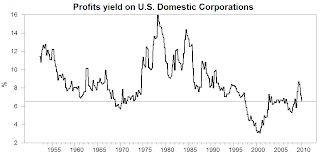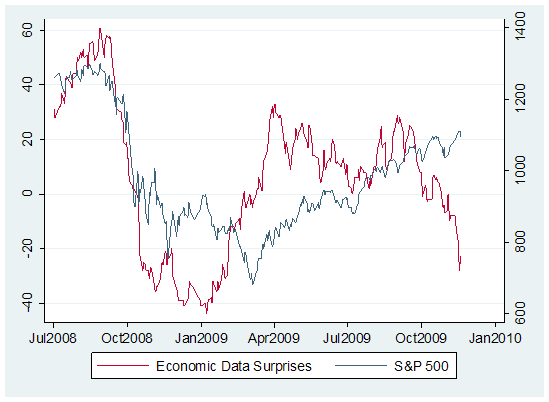In this post I'm looking at the usual and less usual metrics for assessing the current valuation of the dollar price of gold. As we will see they all have their advantages and disadvantages. But before that I would like to show a graph of the performance of the metal over the past ~40 years:
Bubbles are usually characterized by both unsustainable valuations and frantic rates of increases. Concerning the later one, it doesn't seem to have happened yet: the yearly rates of change have been much more muted than during the 1970's bull market - both on the upside and the downside.
Now let's see if valuations can be described as bubblesques. When I made the following charts spot gold was trading at $1148, it is now $1125 as I'm wrapping up this post.
The valuation method that is currently touted the most by gold bulls is the ratio of gold to stocks (here I have used the S&P500):

This method makes current gold prices look very far from bubbly: the current ratio is about the same as the sample period average of 1.21. In the early 1990's, when that ratio was at the same levels, hardly anyone argued that gold was in a bubble (although the metal did head lower for a few more years). Assuming stock prices remain constant or increase, gold would have to increase hundreds of percents for the ratio to come back to 1970's levels. However, another way that this could happen is if it were stock prices that came down (which would hardly surprise me). Also, in theory and in the long run, we should expect stock prices to increase more than gold since equities benefit from productivity increases while gold doesn't. Consequently the ratio doesn't have to go back to 1980 bubble levels. So the ratio is globally favorable, but not a case for a quadrupling in the gold price as others may argue.
Gold prices can also be compared to commodity prices. The problem is, there are many, many commodities, and many indices which track them. I have chosen to use the Producer Price Index: All Commodities from the BLS. It's as good as any.
The ratio of gold to commodities is close to the sample period highs reached in 1980, and if you believe (as I do) that it is more likely the ratio will go back down rather than make new highs, then there are two possible conclusions: either gold has to come down, or commodity prices have to increase more than gold prices. I'm of the latter view.
One of the most popular way to value gold is to look at its real (inflation-adjusted) price:
Here the picture is not pretty either: adjusted to inflation, the gold price is low only when compared to the bubble years (and that's hardly an argument for a value investor). In fact, it is almost twice the sample period average, and thus much closer to bubble level than to fair value (if there is such a thing).
However, one can make the case that reported figures for inflation are biased, and furthermore, an increasing gold price is a signal of future higher inflation. Very well, let us then look at the price of gold compared to U.S. money supply. Comparing gold with money supply should be informative, notably with regards to future inflation:
Of course the supply of gold itself has increased, but by all accounts this increase has been almost negligible. As you can see, from that angle, although gold is not "dirt cheap" (in fact its price is slightly above the sample period average), it is still quite far from the mid-70's interim top and even further from its 1980 top. In fact it's barely above the 1976 interim low. So this paints a picture more similar to what we learned from the ratio with stock rather than with commodity prices, but with an added advantage: while stock and commodity prices commonly rise and fall, money supply
almost never falls. It simply climbs at higher or lower rates:
The reason is... well I don't know, but I would love to ask a central banker why they won't let money supply fall. Anyway, consequently, it is very unlikely that the gold/money supply ratio will move higher due to a fall in the money supply, and this is why I like this ratio much better than the gold/equities or gold/commodities ratios. In my opinion it is also superior to the gold/CPI ratio (e.g. real gold price) because it is forward looking and not backward looking: inflation is a consequence of past money supply growth.
Finally, let us compare the gold price to the amount of assets held by U.S. households and non-profit organizations (this is mostly housing, equities and bonds). This measure makes sense because many asset allocation experts advise to hold x% of one's assets in gold (x being usually around 5). Here's the chart (once again we neglect the change in the supply of gold):
With the usual caveat that the value of these assets could fall (even further than they already have!), this ratio confirms that gold is quite far from being bubbly at these levels. However, it also confirms that gold is not really cheap anymore.
Conclusion: depending on the ratio you look at, you could make a case that the current dollar price of gold is either relatively fair or completely overvalued. However, I believe I have made a relatively strong case that the ratios in favor of the "fair price" view are the most sensible ones. In my opinion the gold bull market is not yet over and I am not selling. I would even add to my positions at around $1000 an ounce.
Note concerning the sample period. This discussion is based on data for the past 40 years or so, which encompasses only two bulls and one bear market, and is very short relative to gold's five thousand years history. But due to the fact that the price of gold used to be fixed*, and to the unavailability of some data, it becomes quite difficult to go further back in time: can you give me U.S. money supply figures for the 19th century, or U.K. stock prices in the 18th?
* True gold bugs would say that the price of fiat money was fixed to gold...
Sources: Reuters, St. Louis Fed FRED, Federal Reserve Board






























